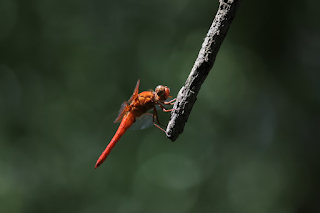We held our 2022 Obon/Hastubon service at the temple on June 10. It was an extra special Obon because it occurred in the wake of a major fire at our temple. The fire occurred in our basement on July 8th due to an electrical malfunction. We are still assessing damage, but we are pleased that our Onaijin (Altar) seems to have survived undamaged. These circumstances helped remind us of the teachings of impermanence and interconnection that are so fundamental to Buddhism.
In Japan, Obon is an important season where the spirits of loved ones who have died return to their homes to join the living in feasting and dancing.
With this background in mind, I would like to share the English translation of lyrics to Obon no Uta, a song that was played at our service:
Riding on dragonflies, guests are returning from the far away Pure Land [of Amida Buddha]!
It’s the yearly visit of our guests.
Dragonfly, dragonfly, red dragonfly!
Guiding the spirits with lights and paper lanterns
We’ll all go out to greet our guests.
I enjoy this view of the ancestors returning to their former homes in the land of the living on the backs of red dragonflies. Over the years, I have appreciated hearing many of our temple members and friends tell their own stories about dragonflies and now I have a few of my own to add. My mother died in January, so this is our hatsubon year, my first Obon without my mother. Last week I was able to go back to the cranberry farm on the coast of Washington where I was raised. One morning I went out on my own and wandered around our farm, nibbling on wild berries, watching the birds, and thinking of all the things my mom had shown me and shared with me on the property over the years. At one point, as I was standing by one of our irrigation ponds, admiring the yellow water lilies, I heard a buzzing and looked down and there was a red dragonfly at my feet. I said, “Oh, hi Ma.” It made me happy to see the dragonfly and in that moment I felt a connection to my mother.
Each year, as the ministers and community members go out and lead short Obon services at the cemeteries in Eastern Oregon and Western Idaho, we find dragonflies of all different colors. The Vale cemetery in particular often has lots and lots of little yellow dragonflies, a species I had never seen before. Who knows? Maybe in Vale the dead return on the backs of yellow dragonflies and not red ones.
Picture: Obon Cemetery Visit at Baker City
I don’t know if I really believe that dragonflies are carrying the spirits of our loved ones back to us during Obon season. But I like the tradition. I like the image. And most of all, I like that every time I see a dragonfly, I am reminded of the people who have come before us.Picture: Obon Dance Practice in the temple basement 2019 (this is the area that was the most damaged in the recent fire)
This Obon let us remember to pause and reflect on those who have come before us. Let us celebrate the relationships with the people who have made our lives possible. We can do that no matter what our beliefs are. Whether they return to us on the backs of red dragonflies, in stories that are shared, in a favorite recipe, or in a piece of craftsmanship and creativity that continues to be part of our lives, the connection between them and us is very real.
In Gassho,
Rev. Anne Spencer
(Assistant Minister, Idaho Oregon Buddhist Temple)







